 Most viewed - KYOTO 京都府 Most viewed - KYOTO 京都府 |
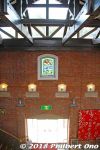
Inside the huge Maizuru World Brick Museum.58 views
|
|
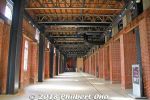
Inside Brick Building No. 5 (赤れんが5号棟), the park's largest building. Built in 1918 to store torpedoes, depth charges, and mines. After the war, it was used by a warehouse company.58 viewsNow used as an event hall and cafe space (cafe open only on weekends). It can be rented to hold exhibitions or events (concerts, weddings, etc.). It has been reinforced with these steel girders for earthquake resistance. National Important Cultural Property.
|
|
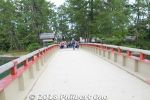
Rotating bridge for Amanohashidate.58 views
|
|
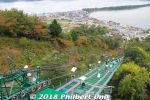
Chair lift to Kasamatsu Park. 58 views
|
|
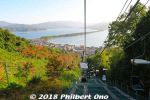
Chair lift down from Kasamatsu Park has nice views.58 views
|
|
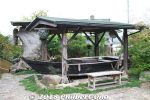
58 views
|
|
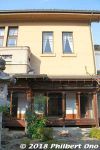
The first floor was Japanese style, while the second floor was Western-style (Spanish).58 viewsFormer Bito family home, Yosano, Kyoto Prefecture.
|
|

57 views
|
|

Keihan Yamashina Station is right next to JR Yamashina Station on the right.57 views
|
|

57 views
|
|

Roof of the Mieei-do Hall.We were not allowed to photograph inside the temple buildings.57 views
|
|

57 views
|
|

Bridge to Benten-shima on Hojo-ike Pond.57 views
|
|

57 views
|
|

Kids' playroom on 2nd floor57 views
|
|

The big Sanmon Gate in the background.57 views
|
|

伽藍堂 (Important Cultural Property)57 views
|
|

Matcha tea and a confection. The tea was outstanding. It had a malty, matcha taste. Pretty thick. The aftertaste was interesting.57 views
|
|

Inside Takumi no Yakata. Like a workshop or classroom for making tea.57 views
|
|
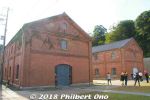
These brick buildings are not open to the public.57 viewsMaizuru Brick Park, Kyoto Prefecture.
|
|

How Amanohashidate was formed, according to mythology.57 views
|
|
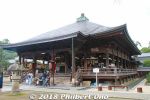
Chionji's main temple hall, Monjudo. 文殊堂57 views
|
|
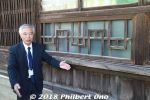
After the Bito Home, we continued our walking tour of Chirimen Kaido Road. 57 viewsOur guide, Aoki Jun'ichi, from Yosano Tourist Association, showed this exterior lattice design featuring the kanji character for "Tan" (from "Tango" 丹後) which is similar (by no coincidence in this case) to the kanji character for "yen" (円).
|
|

Arashiyama is a National Historic Site and Place of Scenic Beauty. This is the Oi River.56 views
|
|

From July 1 to Sept. 23, Arashiyama also has ukai cormorant fishing. Buy your tickets at this booth slightly upstream from Togetsukyo Bridge.56 views
|
|

This path of maples would be redder a several days earlier. Path to Miei-do Hall.56 views
|
|

Whoever landscaped or designed the temple grounds was an artistic genius.56 views
|
|

56 views
|
|

56 views
|
|

56 views
|
|

Little pine cones at Manpukuji.56 views
|
|

Stone grinders grinding matcha (tencha) tea leaves into fine matcha power at Horii Shichimeien's tea factory.56 views
|
|

Small grinder.56 views
|
|

Tango Peninsula coast.56 views
|
|
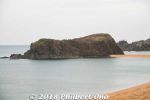
Tateiwa Rock on Tango Peninsula.56 viewsMap (Tateiwa): https://goo.gl/maps/QDHmG1qArez
|
|
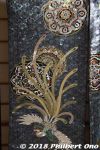
The kimono was woven with pearly shell pieces from five species of oysters. 56 viewsMight be hard to see which parts of the kimono are the shell inlay, but the shiny parts are not the shell pieces. Very glittery.
|
|
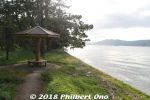
56 views
|
|
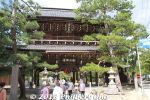
Visitors to Amanohashidate can hardly miss Chionji Temple when you see this large Sanmon gate next to the entrance of Amanohashidate at the southern end. Since you're there, might as well see the temple too. 山門56 viewsMap: https://goo.gl/maps/Anjk19rRLzT2
|
|
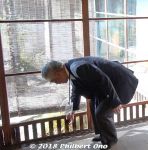
Before air conditioners, they had these sliding slats for ventilation in summer.56 views
|
|

Western-style (Spanish) 2nd floor bedroom.56 views
|
|

55 views
|
|

55 views
|
|

55 views
|
|

Deluxe boat for seeing cormorant fishing.55 views
|
|

Ukai cormorant fishing on the river at Arashiyama was quite enjoyable. It's cheaper than in Gifu, and the cormorants passed by maybe 6 times.55 views
|
|

Manpukuji has a lot of covered corridors linking the major buildings.55 views
|
|

55 views
|
|

Mrs. Horii prepares a different kind of tea.55 views
|
|

It was a room full of stone grinders grinding matcha tea leaves into fine matcha power.55 views
|
|

Sample grinder. The dried tea leaves are fed through a funnel to the grinding stones.55 views
|
|
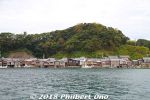
Ine in northern Kyoto Prefecture has 230 funaya boat houses on the waterfront stretching for about 5 km.55 views
|
|
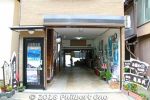
This is the boathouse of Mr. and Mrs. Toshikazu Yamada (山田 敏和), a very friendly fishermen couple who runs Ine boat cruises and work as fishermen.55 viewsThis is what a funaya boat house looks like from the road. First there is a normal car garage. The boat house is not that big.
|
|
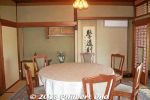
Private dining room at Shoeikan.55 views
|
|

Moto-Ise Kono Shrine torii. No photos beyond this torii.55 views
|
|

Boats for seeing cormorant fishing.54 views
|
|

Deluxe boat for seeing cormorant fishing.54 views
|
|

On board a yakata-bune to view ukai cormorant fishing. Fits about 10 people.54 views
|
|

Grinder face54 views
|
|

Tourists visiting Byodo-in temple can also experience and taste Uji tea at nearby Takumi no Yakata (匠の館).54 views
|
|

Our tea-making kit. Everything is provided.54 views
|
|

54 views
|
|
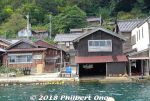
This boat house was used in Tora-san movie No. 29 with Ishida Ayumi and Atsumi Kiyoshi. Looks the same.54 views
|
|

53 views
|
|

53 views
|
|

53 views
|
|

Yakata-bune boat ride at Arashiyama, Kyoto.53 views
|
|

Gifu is not the only place where you can see ukai cormorant fishing.53 views
|
|

Yakata-bune boat steerer.53 views
|
|

53 views
|
|

Stone grinders grinding matcha tea leaves into fine matcha power at Horii Shichimeien's tea factory. Watching these grinders was mesmerizing..53 views
|
|

Entrance to Takumi no Yakata (匠の館).53 views
|
|

In the end, we could even eat the used tea leaves which tasted like spinach maybe.53 views
|
|
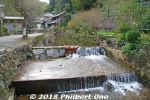
Kurotani village was blessed with this clean Kurotani River, essential for papermaking. Kurotani washi is quite famous now, even overseas.53 views
|
|
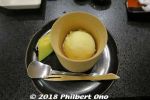
Yuzu sherbet. Yummy!53 views
|
|

52 views
|
|

52 views
|
|

The boats are hitched together.52 views
|
|
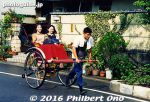
Getting around Arashiyama by rickshaw is popular.52 views
|
|

Some of the finest Uji matcha powder at Horii Shichimeien.52 views
|
|

Some of the finest Uji matcha powder at Horii Shichimeien.52 views
|
|
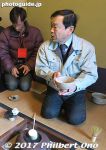
52 views
|
|

Matcha tea leaves to be ground.52 views
|
|

Our instructor (on the left).52 views
|
|

Our tea-making kit. 52 views
|
|

52 views
|
|

These photos were taken while cycling along the Tango Peninsula.52 views
|
|
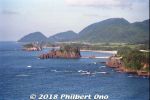
Tango Matsushima (pine islands).52 views
|
|
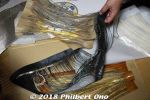
The completed design on washi paper is then sliced into "threads" that will be woven into the fabric.52 views
|
|

Togetsukyo Bridge 渡月橋 51 views
|
|

Togetsukyo Bridge 渡月橋 51 views
|
|

51 views
|
|

51 views
|
|

The ukai cormorant boats operate twice each evening at 7 pm and 8 pm (6:30 pm and 7:30 pm in Sept.). ¥1,800 for adults and ¥900 for kids age 4–12.51 views
|
|

Another cup.51 views
|
|

Tofukuji is a Zen Buddhist temple famous for red maple leaves. Quite spectacular and photogenic landscapes. One of the five great Zen temples of Kyoto. 51 viewsTofukuji temple is the easiest way to see autumn leaves in Kyoto. From Kyoto Station, it's only one train stop (JR Nara Line) away (get off at Tofukuji Station and walk 10 min.). But the trains get sardine-packed in the morning. Expect large crowds during late Nov.
|
|
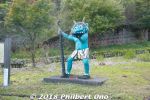
Fukuchiyama also has the Oeyama Mountains, a long mountain range from the neck of the Tango Peninsula to Fukuchiyama. Oeyama is famous for oni (demon, ogre) legends. 51 viewsNear the foot of Oeyama in Fukuchiyama, you may see oni statues like this one.
|
|
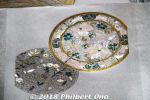
It's a painstaking, time-consuming process.51 views
|
|

Togetsukyo Bridge 渡月橋 50 views
|
|

Togetsukyo Bridge 渡月橋 50 views
|
|

We then got to see Horii Shichimeien's matcha tea factory. (Note that this is not open to normal tourists.)50 views
|
|

Takumi no Yakata was where we could make our own tea (with careful instructions).50 views
|
|

50 views
|
|
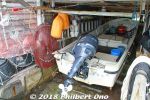
The boat was also hoisted to dry in the garage. Since seawater tended to rot wood, drying the boat when not in use would make the boat last longer.50 views
|
|

49 views
|
|

Our volunteer tour guide.49 views
|
|

His birthplace house is a replica in Yuyadani, Ujitawara. Open only on Sat. and Sun. 49 views
|
|

Grid underneath the hoiro.49 views
|
|

Fukuchiyama Castle was mainly built by Akechi Mitsuhide in 1579 after he conquered this region for Oda Nobunaga.49 views20-min. walk from JR Fukuchiyama Station. Open 9 am–5 pm, closed Tue. and Dec. 28th–31st, Jan. 4th–6th. Map: https://goo.gl/maps/8ZY7HHrDvoC2
|
|
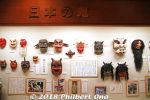
These are oni masks from all over Japan. Very impressive collection of everything oni.49 views
|
|
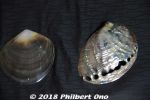
Pearly shells used in their fabrics.49 views
|
|

48 views
|
|
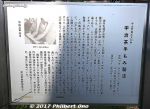
48 views
|
|

Nagatani Soen's birthplace is not easily accessible unless you have a car.48 views
|
|

Inside Nagatani Soen's birthplace home (replica). There's a video explaining the process.48 views
|
|
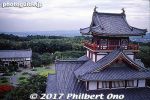
48 views
|
|
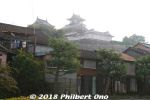
48 views
|
|

Kotohira Shrine's head priest Wakisaka Takuji (宮司 脇坂卓爾) explained it to us.48 views
|
|

Hot water thermos.47 views
|
|

Nagatani Soen's birthplace home (replica).47 views
|
|

Blessed with rolling hills and clear streams, Wazuka produces about 40 percent of Kyoto's Uji tea production. Wazuka is most suited for tea cultivation because there is a large temperature difference between night and day.47 views
|
|

This is the Ishitera area of Wazuka (pop. 4,226 as of Feb. 2016), a small town in southern Kyoto with about 301 Uji tea farmers.47 views
|
|

47 views
|
|

Made of ferroconcrete.47 views
|
|
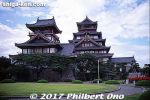
Reconstruction of Fushimi Castle when it was still open to the public from 1964 to 2003. It was a museum about Toyotomi Hideyoshi who built the original Fushimi-Momoyama Castle. This was the main attraction of a small theme park called "Castle Lan.&q47 views
|
|
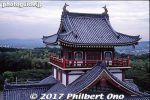
47 views
|
|

About the Shachi roof ornament replica.47 views
|
|
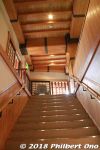
Inside the castle tower is a modern building housing a local history museum. Photography is not allowed inside the castle museum.47 views
|
|
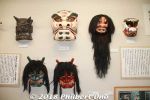
"Oni" has no real equivalent word in English. It's usually a fearsome or hellish figure with negative connotations. It always has horns on the head, but it's not really a devil. 47 viewsOni are generally perceived to be mean, cruel, evil, or bad luck. So if someone calls you an "oni," it means you're mean, cruel, or always angry. But there may be protective and benevolent ones as well.
|
|
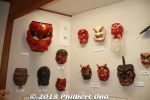
Tengu goblin masks.47 views
|
|
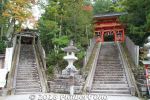
Established in 1811, Kotohira Jinja Shrine (nicknamed Konpira-san 金刀比羅神社) in Kyotango, Kyoto mainly worships Konpira (aka Kompira), the god who protects sailors, fishermen, ocean transport, navy personnel, and other seafaring people. 47 viewsPeople also pray here for business prosperity, family safety, scholastic excellence, safe childbirth, recovery from illness, and more. There are at least 30 Kotohira/Konpira Shinto shrines in Japan and the headquarters shrine is Kotohira-gu Shrine in Kotohira, Kagawa Prefecture in Shikoku.
|
|

Tango Matsushima (pine islands).47 views
|
|
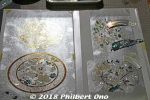
First they attach the thin shell/pearly layers on a design on washi paper.47 views
|
|

First cup of tea.46 views
|
|

46 views
|
|

46 views
|
|

46 views
|
|

46 views
|
|
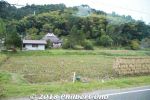
This is a farmhouse lodge (農家民宿) where we stayed in the city of Ayabe. It fronts rice paddies. The farmhouse lodge owner can pick you up at JR Ayabe Station.46 views
|
|
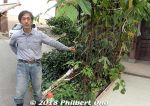
Kurotani washi mainly uses kozo or mitsumata mulberry plants as the raw material. This is our Kurotani washi guide showing us the kozo plants that can grow to three meters high.46 viewsThey are harvested in autumn by cutting the trunks or branches. They grow kozo mulberry near Ayabe Station. Kozo is called "kago" in Kurotani.
|
|
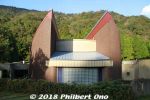
Japanese Oni Exchange Museum exhibits oni (demon, ogre) artwork and local oni legends of the Oeyama Mountains. Masks, statues, kawara roof tile ornaments, and paintings of oni from all over Japan and some from overseas. 46 viewsAll donated to the museum. The museum is at the foot of the Oeyama Mountains (大江山). The Oeyama mountains are known for famous oni legends. That's why this museum was built here.
|
|
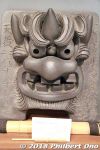
Kawara roof oni ornament. Oni-gawara.46 views
|
|
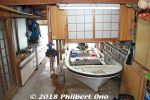
In the back of the car garage is the boat garage on the water's edge. The small fishing boat is hoisted and secured by a power winch. 46 viewsAbove the boat is just storage space (not another room). The family uses the boat to catch fish for themselves.
|
|
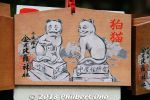
Koma-neko ema prayer tablet.46 views
|
|
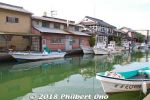
46 views
|
|
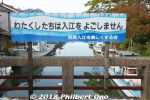
Walk until this bridge going over the inlet. Banner says, "We won't pollute the inlet."46 views
|
|

Kaijusenji's five-story pagoda is a National Treasure, built in 1214.45 views
|
|

45 views
|
|

Slow Life Cafe45 views
|
|

45 views
|
|

Fog thereby forms over the tea plants to shade them from the strong sunlight. Tea plants also grow best in well-drained soil, hence the tea plants on sloping land.45 views
|
|

45 views
|
|

45 views
|
|

45 views
|
|

View from Fushimi Castle.45 views
|
|

45 views
|
|

45 views
|
|
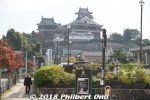
Fukuchiyama Castle's main tower was reconstructed in 1986 funded mostly by donations by the public and subsidies from the Japanese government. Hardly any local tax money from Fukuchiyama was used.45 views
|
|
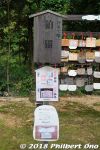
"Koma-neko Unique in Japan"45 views
|
|
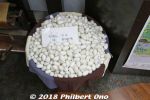
This is 3,000 silk cocoons. That's how much silk is needed to make silk fabric for one kimono. One cocoon has 1200–1500 meters of silk thread. 45 viewsSince Japan produces very little silk, most are imported from China and Brazil. The Tango region consumes about one-third of Japan's raw silk imports. We were told the quality of silk from China and Brazil is very good.
|
|
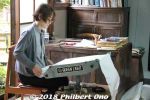
Chirimen fabric inspector uses a light box to carefully check for any defects and flaws in the material. Any defects in the material will reduce its value and the fabric (or kimono) will be sold for less.45 views
|
|
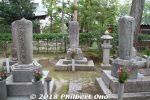
45 views
|
|

Built in the Nara Period, Kaijusenji is a Chisan-ha Shingon Buddhist temple. It worships an eleven-face Kannon statue. 44 views
|
|

First floor of pagoda.44 views
|
|

44 views
|
|

Kamikoma is a neighborhood of about 40 Japanese tea wholesalers. There is some traditional buildings, and only one or two buildings where the public can enter.44 views
|
|

44 views
|
|

44 views
|
|

44 views
|
|

View from Tsutenkyo Bridge. That bridge in the distance is where you enter the temple.44 views
|
|

44 views
|
|
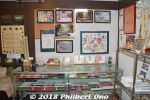
Inside Kurotani Washi Kaikan gift shop.44 views
|
|
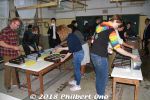
Afterward, we could decorate our postcards with colored ink/fibers.44 views
|
|
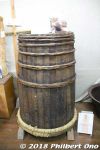
To make the paper fibers for washi, there are many laborious steps. After the kozo branches are cut in even lengths, they are stuffed in a barrel (koshiki) like this and placed over a boiling and steaming iron pot for three to four hours 44 viewsto soften the brown bark.
|
|
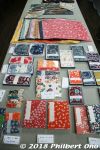
44 views
|
|
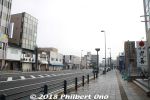
From Fukuchiyama Station, a straight road to Fukuchiyama Castle.44 views
|
|
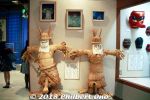
44 views
|
|
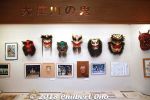
Oni masks based on Oeyama's three famous oni legends, especially "Shuten-doji" (酒呑童子).44 views
|
|
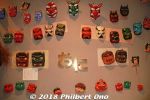
44 views
|
|
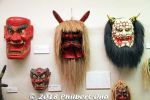
44 views
|
|
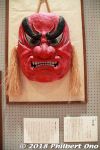
44 views
|
|
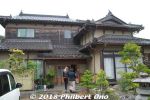
Tango chirimen silk fabric maker Tamiya Raden (民谷螺鈿).44 views
|
|
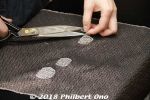
Working on an obi sash. 44 views
|
|
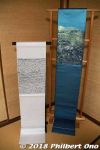
Tamiya Raden also makes kimono obi sashes.44 viewsThey also supply fabrics to world-famous luxury brands, but they can't brag about it because of a non-disclosure agreement.
|
|

Present main temple hall built in 1884.43 views
|
|

43 views
|
|

43 views
|
|

43 views
|
|

43 views
|
|

Long line to enter Tofukuji, but it progressed quickly enough.43 views
|
|

The trees are very well placed and very photogenic.43 views
|
|

43 views
|
|

43 views
|
|

43 views
|
|

43 views
|
|

43 views
|
|

About sugeta.43 views
|
|
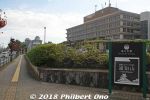
Near Fukuchiyama City Hall, Fukuchiyama Castle.43 views
|
|
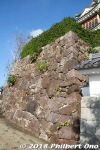
43 views
|
|
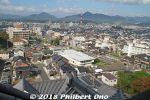
Top floor of the castle tower gives great views of the city. This is toward City Hall and Fukuchiyama Station.43 views
|
|
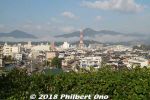
43 views
|
|
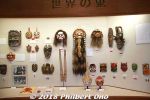
Oni even from overseas. 43 views
|
|
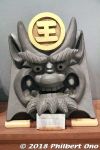
Kawara roof oni ornament. Oni-gawara.43 views
|
|
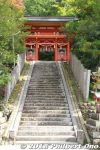
This shrine in Mineyama, Kyotango greatly benefited from the patronage of rich, local Tango chirimen makers and it is unique for its koma-neko cat guardians.43 views
|
|
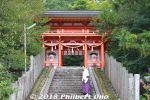
43 views
|
|
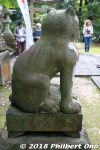
Back view of Koma-neko.43 views
|
|
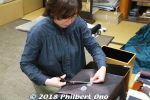
Working on an obi sash. 43 views
|
|
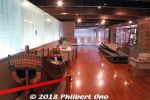
Maizuru World Brick Museum on the upper floor. Exhibits local historical artifacts. There's no English though.43 views
|
|
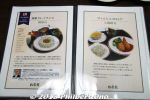
The restaurant's menu is quite cheap, prices ranging from ¥900 for Navy curry rice to ¥4,500 for a full course.43 views
|
|

Belonging to the Rinzai Zen Sect, Chionji worships the Manjushri bodhisattva (Monju Bosatsu) for wisdom and academic abilities. Many students pray here. 43 views
|
|
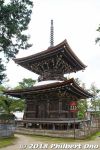
Chionji Temple's Tahoto Pagoda is the Tango region's only relic remaining from the Muromachi Period. 多宝塔43 views
|
|

42 views
|
|

42 views
|
|

42 views
|
|

42 views
|
|

42 views
|
|

42 views
|
|

42 views
|
|

42 views
|
|

42 views
|
|

42 views
|
|

42 views
|
|

Sanmon Gate, Tofukuji's main gate. National Treasure.42 views
|
|
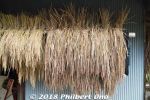
42 views
|
|
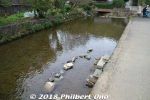
42 views
|
|
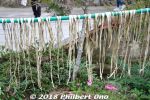
The brown kozo bark is shaved and scraped with a knife by hand to remove the brown bark skin and other blemishes. Then the becomes thin, white strips that are dried in the sun. (shiro-kawa 白皮)42 views
|
|
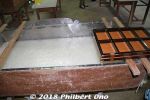
A large vat (sukifune) filled with washi fibers floating evenly in the water. The fibers are mixed in with a plant-based adhesive so they don't sink to the bottom and they also cling together to make the paper. 42 viewsA wooden mold (keta 桁) to make eight postcards on the right. Kurotani washi bills itself as Japan's strongest paper. In the 1920s, Kurotani washi was tested for strength and was declared the strongest washi in Japan. I was told Kurotani's kozo has longer fibers than other species so the paper is stronger.
|
|
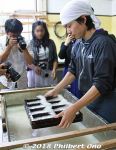
Dump the postcard mold into the vat and swish it left/right and forward/back evenly.42 views
|
|

The postcards looked quite thick out of the mold, but they would get much thinner when dried.42 views
|
|
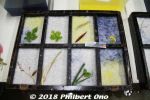
A few people even embedded leaves.42 views
|
|
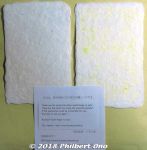
They later sent us our postcards. Mine came out okay.42 views
|
|
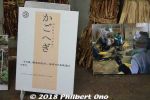
42 views
|
|
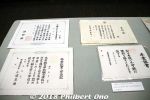
Local public schools have their kids make their diplomas with Kurotani washi.42 views
|
|
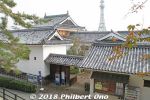
Sato Taisei Memorial Museum42 views
|
|
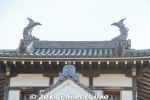
Roof ornaments42 views
|
|
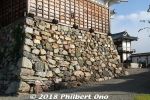
42 views
|
|

42 views
|
|
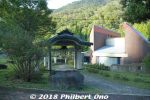
The town wanted to promote itself as an oni town, so it opened the Japanese Oni Exchange Museum in 1993 on the former site of a copper mine at the foot of Oeyama Mountains.42 views
|
|
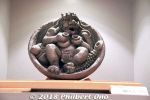
42 views
|
|
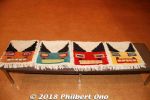
Bench42 views
|
|
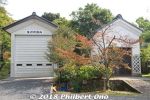
Sorehouse for the shrine's festival float and mikoshi portable shrine.42 views
|
|
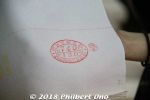
Seal of approval on chirimen fabric. 42 views
|
|
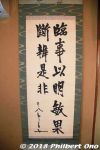
42 views
|
|
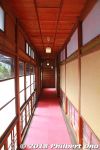
42 views
|
|
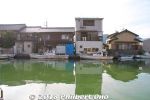
The homes used to have built-in boat garages like at Ine, but they were abolished and the boats are moored right in front instead. 42 views
|
|
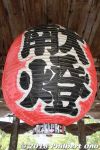
Paper lantern in Sanmon Gate.42 views
|
|
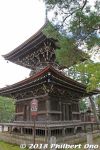
Chionji Temple's Tahoto Pagoda. 多宝塔42 views
|
|
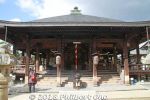
Chionji's main temple hall named the Monjudo. 文殊堂42 views
|
|

41 views
|
|

41 views
|
|

41 views
|
|

41 views
|
|

We could go inside this building.41 views
|
|
| 2715 files on 11 page(s) |
 |
 |
 |
9 |  |
|